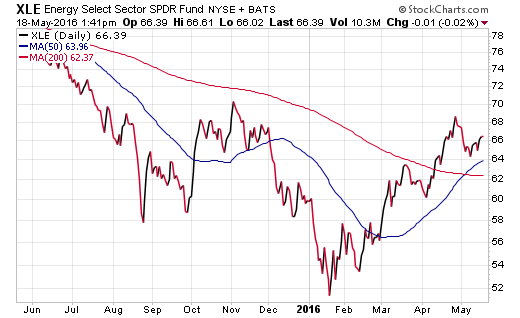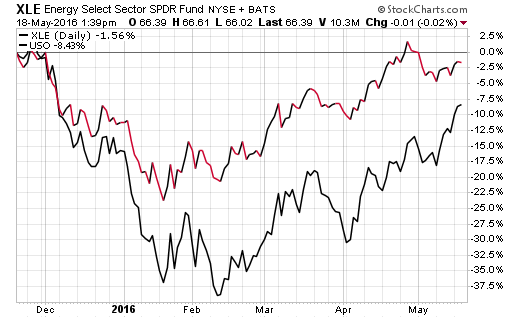Everyone hated energy ETFs last year as plunging oil and natural gas prices eroded valuations of companies engaged in this sector. The weakening demand for global commodities wrought havoc among large oil producers, exploration companies, and even storage conglomerates.
Fast forward to 2016, and the narrative has turned from one of relative weakness to an important mainstay of broad market momentum. The Energy Select Sector SPDR (XLE) has ripped more than 20% from its lows and is now the second strongest sector on a year-to-date basis behind utility stocks.
XLE tracks 40 large cap oil and gas stocks that include recognizable mega companies Exxon Mobil Corp (XOM) and Chevron Corp (CVX). This ETF has $14 billion in total assets and charges an expense ratio of 0.14%.
As you can see on the chart below, XLE has been consistently trending above its 50-day moving average (smooth blue line) since mid-February. The solid strength behind this move has been driven by a resurgence in crude oil prices alongside a concomitant weakening of the U.S. dollar. Both factors are supportive of the fundamental story behind oil stocks.

Furthermore, XLE has proven to be an important counter-trend component of the more recent consolidation here in May. While many beloved areas of the market have stalled due to valuation concerns, energy stocks have continued to work under the radar. This is a significant change in character compared to the outsized volatility and “sell at any cost” mentality that this sector traded through last year.
Of course, moving forward, the story for energy ETFs is going to be driven heavily by their correlation with oil prices. The chart below shows just how correlated XLE has been with the United States Oil Fund (USO) over the last six months. A consolidation or weakening of the commodities trend may ultimately reign in the hard won momentum that these stocks have created.

The halo effect of energy stocks can be felt throughout many other areas of your portfolio as well. For example, dividend-focused indexes are often loaded with energy companies. The iShares Core High Dividend ETF (HDV) has 21% of its portfolio in the energy sector. Similarly, the master limited partnerships that make up the Alerian MLP ETF (AMLP) will be heavily influenced by the fluctuations in commodity prices.









Leave A Comment